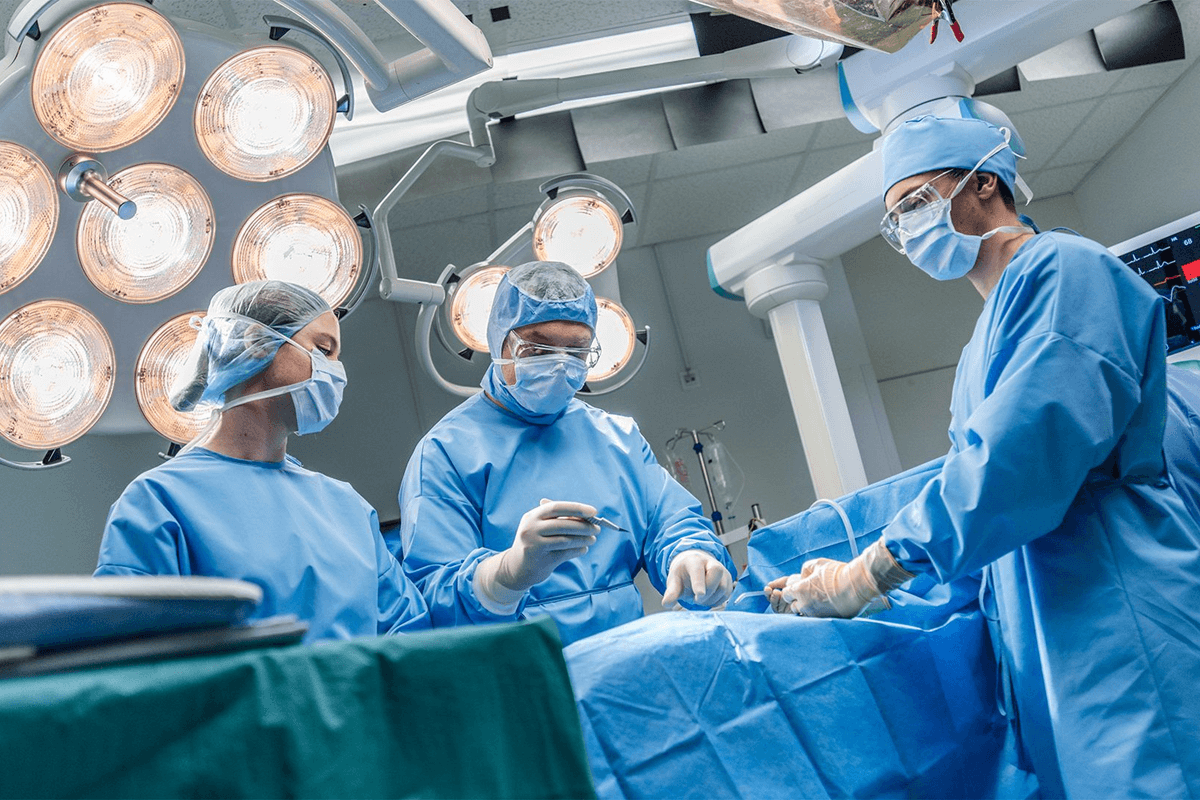Last Updated on November 26, 2025 by Bilal Hasdemir

Medical treatments are always getting better, thanks to non-invasive operations. These methods don’t hurt the skin or go inside the body. A non-invasive operation means any treatment that doesn’t cut the skin or go into the body’s cavities.
Things like X-rays, CT scans, and MRI are examples. So are tests like ECG and Holter monitoring. These non invasive operations are safer than old-school surgery. They lower the chance of problems and help you get better faster.
Key Takeaways
- Non-invasive operations avoid breaking the skin or entering internal body cavities.
- Examples include x-rays, CT scans, MRI, ECG, and Holter monitoring.
- These procedures reduce the risk of complications compared to traditional surgery.
- Non-invasive operations promote quicker recovery times.
- They are a safer alternative for patients requiring diagnostic or therapeutic interventions.
Defining the Non-Invasive Operation in Modern Medicine

Modern medicine has moved towards non-invasive operations. These focus on keeping patients safe and comfortable. Non-invasive procedures are used for both diagnosis and treatment. They avoid breaking the skin, cut down recovery times, and lower the risk of complications.
Core Characteristics and Principles
Non-invasive operations have a minimal impact on the body. The main principles are:
- Minimally disruptive: These procedures don’t need incisions or instruments inserted into the body.
- Reduced risk: They lower the risk of infection and other complications by avoiding invasive methods.
- Faster recovery: Patients recover faster, getting back to their normal activities sooner.
Non-invasive treatments have many benefits. They are appealing to both patients and healthcare providers.
Historical Evolution of Non-Invasive Techniques
The growth of non-invasive techniques has been slow but steady. It’s been driven by medical technology advancements and a better understanding of human physiology. At first, non-invasive procedures were just simple diagnostic tools. But with new technology, they now include complex treatments.
Some important milestones in non-invasive operations include:
- The introduction of MRI and CT scans.
- The development of laser therapy for various medical conditions.
- The use of ultrasound for both diagnosis and treatment.
These advancements have made non-invasive operations a key part of modern medicine. They offer safe and effective treatments for many conditions.
The Science and Technology Behind Non-Invasive Procedures

Non-invasive procedures use the latest technology and know-how of human anatomy. We’ve seen big steps forward in medical tech, making non-invasive methods more popular. These changes have made healthcare better, with faster recovery, less pain, and smaller scars.
Fundamental Scientific Principles
Non-invasive methods rely on key scientific ideas. One idea is using outside energy to help or diagnose without cutting the skin. For example, ultrasound technology uses sound waves to see inside the body. Laser therapy uses light to treat different issues.
Another important idea is using new materials and tools that work with the body from outside. This includes devices you can wear that check your health or help without implants.
Role of Advanced Medical Imaging
Advanced medical imaging is key in non-invasive care, helping with accurate diagnoses and plans. Tools like MRI (Magnetic Resonance Imaging) and CT (Computed Tomography) scans show inside details without surgery.
These images help doctors diagnose and plan treatments. During non-invasive procedures, imaging lets doctors see and adjust treatment as it happens.
Medical imaging keeps getting better, with clearer, faster images and more info on body parts. These updates help create new non-invasive treatments and make old ones safer and more effective.
Common Types of Non-Invasive Operations
The field of non-invasive treatments is wide and includes many types of procedures. These methods have changed how we diagnose and treat health issues. They offer safer options than traditional surgery.
Diagnostic Non-Invasive Procedures
Diagnostic non-invasive procedures help find and track health problems without surgery. They include:
- Imaging Techniques: X-rays, CT scans, MRI, and ultrasound help see inside the body and find issues.
- Cardiac Monitoring: ECG and Holter monitoring check the heart’s activity and find heart problems.
- Neurological Tests: EEG checks the brain’s electrical activity.
These tools help doctors make correct diagnoses and plan the best treatments.
Therapeutic Non-Invasive Procedures
Therapeutic non-invasive procedures treat many health issues without surgery. Examples are:
- Physical Therapy: Helps patients get better after injuries or surgery, improving movement and strength.
- Radiotherapy: Treats cancer by using high-energy radiation to target cancer cells.
- Massage Therapy: Relaxes muscles and reduces tension.
- Chiropractic Adjustments: Improves spinal alignment and relieves nervous system pressure.
These treatments offer effective options with less risk and quicker recovery than surgery.
| Procedure Type | Examples | Benefits |
| Diagnostic | X-rays, CT scans, MRI, ECG, Holter monitoring | Accurate diagnosis without surgery |
| Therapeutic | Physical therapy, radiotherapy, massage therapy, chiropractic adjustments | Effective treatment with fewer risks and less recovery time |
Key Benefits of Choosing a Non-Invasive Operation
Modern medicine has made great strides with non-invasive operations. These offer a safer option than traditional surgery. Thanks to new medical tech and a better understanding of their benefits, we’re seeing more non-invasive procedures.
Reduced Recovery Time and Hospital Stays
Non-invasive operations lead to faster recovery times and shorter hospital stays. This is because they don’t need big cuts or damage to tissues. So, the body suffers less.
Lower Risk of Infection and Complications
Non-invasive procedures have a lower risk of infection and complications. Without surgical cuts, the chance of post-op infections and other issues drops. This makes them safer than invasive surgeries.
Decreased Pain and Discomfort
Patients feel less pain and discomfort with non-invasive operations. This is because they cause less damage and trauma. It’s a gentler approach.
Economic Advantages for Patients and Healthcare Systems
Non-invasive operations save money for both patients and healthcare systems. They cut down on recovery times and hospital stays. This lowers costs. Plus, less need for post-op care and rehab adds to the savings.
In summary, non-invasive operations offer many benefits. They reduce recovery times, lower risks, and cut down on pain. They also save money. As medical tech improves, we’ll see more of these procedures.
Invasive vs. Non-Invasive Procedures: Understanding the Fundamental Differences
It’s important for patients and doctors to know the difference between invasive and non-invasive medical procedures. These differences affect how patients are cared for, how they recover, and the results they get.
Procedural Approach Distinctions
Invasive procedures mean going into the body through the skin or cavities, often with surgery. On the other hand, non-invasive procedures don’t go through the skin or into cavities. This means less damage to tissues and quicker healing.
The way to treat a medical issue can change a lot between invasive and non-invasive methods. For example, traditional surgery needs big cuts, leading to longer healing times and more risks. This is compared to minimally invasive surgery, which is safer and faster.
Anesthesia Requirements
Anesthesia needs are different for invasive and non-invasive procedures. Invasive surgeries often need general anesthesia or strong sedation because of the big cuts and tissue involved. But, many non-invasive treatments can be done with little to no anesthesia. This lowers risks and shortens recovery times.
Recovery Process Comparison
Recovery times are a big difference between invasive and non-invasive procedures. Invasive surgeries mean longer hospital stays and longer healing times. But, non-invasive procedures usually let patients go home the same day and get back to normal life sooner.
| Characteristics | Invasive Procedures | Non-Invasive Procedures |
| Skin Penetration | Yes | No |
| Anesthesia Requirement | Often General Anesthesia | Minimal or No Anesthesia |
| Recovery Time | Extended | Shorter |
Risk Profile Analysis
Invasive and non-invasive procedures have different risks. Invasive procedures have higher risks of infection, complications, and long-term damage. But, non-invasive treatments have lower risks, though they might not work for all conditions.
Knowing these differences is key to making smart choices about medical care. By looking at the procedure, anesthesia, recovery, and risks, patients and doctors can pick the best treatment.
Minimally Invasive vs. Non-Invasive: Clarifying Common Misconceptions
Minimally invasive and non-invasive procedures are often confused with each other. But they differ in how they approach treatment. It’s important for patients and doctors to understand these differences to make the best choices.
Defining the Spectrum of Invasiveness
“Invasiveness” means how much a medical procedure affects the body. Non-invasive procedures don’t go through the skin or into body cavities. They use outside methods to diagnose or treat.
Minimally invasive procedures make small cuts or go through the skin or cavities. They use new technology to keep the intrusion small.
Non-invasive surgery doesn’t cut the skin. This makes it different from both invasive and minimally invasive surgeries. Minimally invasive surgery makes small cuts and uses special tools for the operation.
Clinical Scenarios for Each Approach
Non-invasive treatments work well for some conditions. For example, tests like MRI or treatments like radiation therapy for cancer. Minimally invasive procedures are better for conditions needing direct access inside without big cuts, like laparoscopic surgery for gallbladder removal.
We look at many things when choosing between these options. This includes the patient’s health, the condition’s nature, and the risks and benefits of each procedure.
Decision Factors for Treatment Selection
Choosing between minimally invasive and non-invasive treatments involves several factors. These include the condition’s severity, the patient’s health history, and their preferences. The goal is to find the most effective treatment with the least risk and discomfort.
- The specific condition being treated and its severity.
- The patient’s overall health and any comorbidities.
- The benefits and risks of each approach.
- Patient preferences and values.
Healthcare providers can help patients choose the best treatment. This could be a non-invasive procedure or a minimally invasive surgery.
Non-Invasive Treatment Options Across Medical Specialties
Non-invasive treatments are now key in many medical fields. They offer safer choices than old surgeries. This change is making healthcare better and safer for patients.
Cardiology Applications
In cardiology, non-invasive tests are used a lot for checking the heart. ECGs and echocardiograms are common. They help doctors see heart health without surgery.
Neurology Approaches
Neurology also benefits from non-invasive tests, like MRI and CT scans. These scans give clear views of the brain and nervous system. They help doctors diagnose and treat better.
Orthopedic Therapies
Orthopedics is seeing more non-invasive treatments too. Physical therapy, shockwave therapy, and injections are used. They help without surgery, cutting down recovery time and risks.
Oncology Applications
In oncology, treatments like radiotherapy and imaging are non-invasive. Radiotherapy targets tumors with precise radiation. It’s a key treatment for many cancers, protecting healthy tissue.
Healthcare is getting better with non-invasive treatments. They help patients recover faster and have better results. As technology grows, non-invasive care will become even more important.
Patient Experience During Non-Invasive Operations
Knowing what to expect during a non-invasive operation can help reduce anxiety. We help patients understand what happens during these procedures. This way, they feel informed and comfortable during their treatment.
Preparation Guidelines
Before a non-invasive operation, patients get specific guidelines. These include dietary restrictions, changes to medication, and other steps to help the procedure succeed.
- Dietary Restrictions: Patients might be told to avoid certain foods or drinks beforehand.
- Medication Adjustments: Some medications may need to be paused or adjusted before the operation.
- Pre-Procedure Testing: Certain tests may be required to ensure the patient’s safety during the procedure.
What to Expect During the Procedure
During a non-invasive operation, patients go through a series of steps. “The advancements in medical technology have made non-invasive procedures highly effective and safe,” say medical experts.
The procedure is done in a controlled setting, like a hospital or outpatient clinic. It’s staffed by experienced healthcare professionals.
Post-Procedure Care and Follow-up
After the procedure, patients are watched for a short time to check for any immediate issues. We stress the importance of post-procedure care and follow-up appointments. These help monitor recovery and address any concerns.
“Proper post-procedure care is key for the best recovery and outcomes,” says a leading healthcare professional.
Follow-up care includes:
- Monitoring for any complications
- Managing pain or discomfort
- Slowly getting back to normal activities
By understanding non-invasive operations, patients can feel more confident and ready for their treatment.
Technological Innovations Advancing Non-Invasive Operations
New medical technologies are making non-invasive operations safer and more effective. We’re seeing big changes in healthcare thanks to these advanced tools.
Artificial Intelligence Integration
Artificial intelligence (AI) is key in non-invasive procedures. AI can quickly look through lots of medical data. This helps doctors make better diagnoses and treatment plans.
AI also improves diagnostic images. This means doctors can spot problems earlier. Plus, AI can predict patient outcomes by finding patterns in data. This leads to better care and treatment.
Robotics and Remote Procedures
Robotics are making non-invasive surgery better. Robots help surgeons do complex tasks with more precision. They also make it possible for surgeons to operate from another place.
This is great for emergencies or when patients can’t see a specialist. Robotics and fast networks make remote surgery possible.
Wearable Diagnostic Devices
Wearable devices are getting smarter. They let doctors keep an eye on patients’ health all the time. This means doctors can act fast if something goes wrong.
These devices also let patients check their health themselves. They get alerts if something doesn’t look right.
Future Directions in Non-Invasive Medicine
We’re expecting even more progress in non-invasive medicine. Technologies like AI, robotics, and wearable devices will keep getting better. New things like augmented reality and nanotechnology will also be important.
As these technologies grow, non-invasive procedures will get safer and more effective. More patients will have access to better care. We’re excited to see where these advancements take us.
Limitations and Challenges of Non-Invasive Approaches
Non-invasive methods have changed medicine a lot. They help patients recover faster and reduce infection risks. But, there are some downsides to consider.
Diagnostic Accuracy Considerations
One big issue with non-invasive methods is making sure they’re accurate. Non-invasive diagnostic techniques like imaging have gotten better. Yet, they might not always be precise enough for tough diagnoses.
- Limited resolution in certain imaging modalities
- Difficulty in detecting early-stage diseases
- Potential for false positives or negatives
To fix these problems, we’re working on better imaging and new tools. We want to keep these methods non-invasive but more accurate.
Treatment Efficacy Limitations
Another big thing to think about is how well non invasive treatments work. They’ve shown good results in many areas of medicine. But, their success depends on the condition being treated.
Some chronic diseases might need more invasive treatments for the best results. We have to decide if non-invasive methods are right for each patient. We look at how serious the condition is and the patient’s health.
Accessibility and Availability Issues
Lastly, getting to invasive non-invasive procedures can be hard. Not every hospital has the latest non-invasive tech. Access to these treatments can vary a lot, depending on where you live and how much money you have.
- Limited availability of specialized training for healthcare professionals
- High costs associated with advanced non-invasive technologies
- Disparities in access to care in different regions
To solve these problems, we need to educate more people, improve our healthcare setup, and make sure everyone can get these treatments.
Conclusion: The Evolving Landscape of Non-Invasive Healthcare
Non-invasive operations have changed healthcare a lot. They offer many benefits like less recovery time, lower infection risk, and less pain. It’s important to know what non invasive surgery and procedures mean to understand these advances.
Liv Hospital leads in non-invasive operations, focusing on patient comfort and quick recovery. The future of healthcare looks bright with more non-invasive techniques. This will make treatments better and more comfortable for patients.
The move to non-invasive healthcare is all about putting patients first. Hospitals are leading this change. By using the newest non-invasive medicine, doctors can give top-notch care with less discomfort and downtime for patients.
FAQ
What is a non-invasive operation?
A non-invasive operation is a medical procedure that doesn’t break the skin or enter the body. It’s safer for patients and helps them recover faster.
How do non-invasive operations differ from invasive procedures?
Non-invasive operations are different from invasive ones in many ways. They need less anesthesia, have quicker recovery times, and are less risky. This makes them a better choice for many patients.
What are the benefits of choosing a non-invasive operation?
Choosing a non-invasive operation has many benefits. Patients recover faster, face less risk of infection, and feel less pain. It also saves money for both patients and healthcare systems.
What are some examples of non-invasive diagnostic procedures?
Examples of non-invasive diagnostic procedures include MRI and CT scans. These tests help doctors diagnose without needing to cut the skin.
Can non-invasive operations be used for therapeutic purposes?
Yes, non-invasive operations can treat many conditions. For example, physical therapy and radiotherapy are used to help patients without surgery.
How do non-invasive operations impact patient outcomes?
Non-invasive operations improve patient outcomes in many ways. They reduce recovery times, lower risks, and decrease pain. This leads to happier patients.
What is the difference between minimally invasive and non-invasive procedures?
Minimally invasive procedures use small cuts, while non-invasive ones don’t need cuts at all. The choice depends on the situation and the procedure.
Are non-invasive operations available across different medical specialties?
Yes, non-invasive operations are used in many specialties. Cardiology, neurology, orthopedics, and oncology all use them. Each specialty has its own non-invasive methods.
What can patients expect during a non-invasive operation?
Patients can expect some preparation before the procedure. They’ll be watched during it and get care after. The details vary by procedure.
What technological innovations are advancing non-invasive operations?
New technologies like AI, robotics, and wearable devices are improving non-invasive operations. They help doctors diagnose and treat more accurately.
What are the limitations and challenges of non-invasive approaches?
Non-invasive methods face challenges like accuracy and treatment effectiveness. There are also issues with access and availability. These need to be solved to make non-invasive care better.
What is the future of non-invasive healthcare?
The future of non-invasive healthcare looks bright. New tech and research are making it better. Places like Liv Hospital are leading the way with patient-focused care.
References
Peng, J., et al. (2024). Systematic review and meta-analysis of current evidence in uterine artery embolization compared to myomectomy on symptomatic uterine fibroids. Scientific Reports, 14, Article 12345. https://www.nature.com/articles/s41598-024-69754-0






